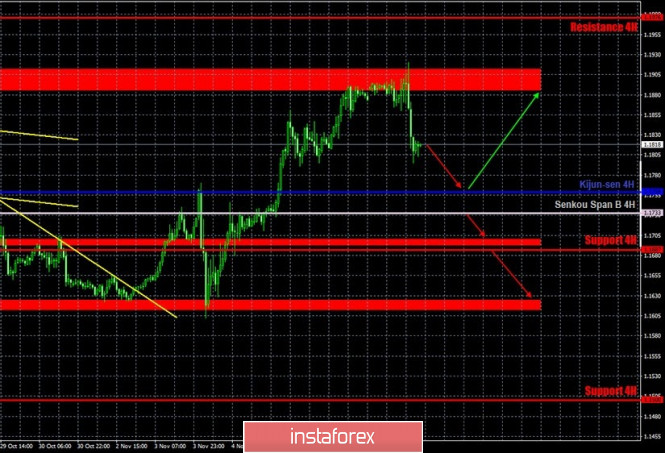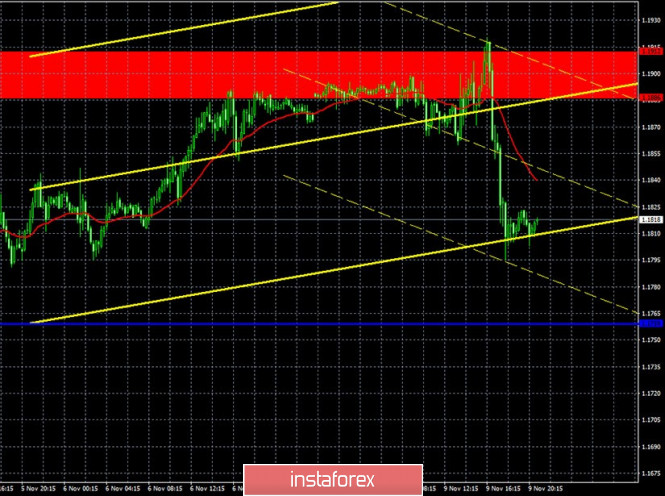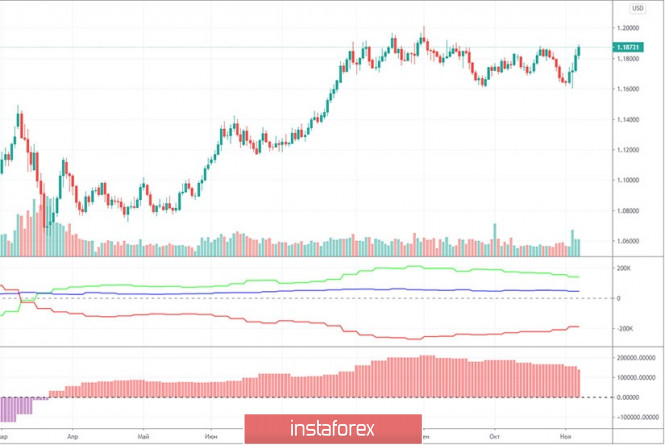EUR/USD 1H

The EUR/USD pair traded near the resistance area of 1.1886-1.1912 for quite some time on the hourly timeframe on Monday, November 9, and it finally rebounded off it and fell during the US session. Therefore, yesterday's forecasts that predicted a rebound from this area were correct. And since the pair did not settle above this area, traders could open short positions during the day. The nearest target is the Kijun-sen line. In general, the upward trend is still maintained for the EUR/USD pair. Precisely because the quotes remain above the critical line. And as long as the price is above this line, the outlook for the bulls remains quite good. However, we have already repeatedly drawn attention to the fact that it will be extremely difficult to overcome the 1.1900 level. And from a fundamental point of view, there is no reason for it to rise above the 1.1900 level. Thus, we are more inclined towards the option of the euro's fall. However, sellers need to overcome the Senkou Span B and Kijun-sen lines in order for a full downward trend to form.
EUR/USD 15M

The lower linear regression channel has already turned to the downside on the 15-minute timeframe, and the higher one can do so in the near future. A closer look at the technical picture shows an even more eloquent rebound from the 1.1886-1.1912 area, as well as the fact that buyers failed to overcome it within 28 hours. Sellers' further prospects lie below the Kijun-sen and Senkou Span B.
COT report

The EUR/USD pair lost 170 points during the last reporting week (October 27-November 2).
A strong upward movement began after this time range. Therefore, the fact that the pair gained 220 points simply does not fall within the timeframe of the latest Commitment of Traders (COT) report. According to it, professional traders closed 9,200 Buy-contracts (longs) and opened 7,800 Sell-contracts (shorts). Thus, the net position for non-commercial traders decreased by 17,000 at once. And any decrease in the net position indicates a strengthening of the bearish mood. Consequently, professional traders continue to look towards selling the euro. Therefore, even despite the subsequent growth, we still believe that the high near the 1.2000 level will still be the peak of the entire upward trend. At least the COT data continues to signal just that. The technical analysis may contradict the COT report, as the latter comes out with a three-day delay. We cannot now know how the big players behaved in the period from November 3 to 6, which is when the dollar was significantly falling due to the elections. Indicators are also signaling good prospects for a new downward trend, as the green and red lines continue to narrow (the first indicator). And they, we recall, reflect the net positions of non-commercial traders and commercial ones.
No macroeconomic releases for America and the European Union on Monday. Therefore, traders had nothing to react to during the day. However, as we mentioned earlier, the tension in the market should have started to subside, and at the same time the US dollar should have started to rise. Last week, the dollar was under pressure solely due to political factors. However, over the weekend it became reliably known that the election was won by Joe Biden, therefore, the dollar should have received a respite at least for a while. At least for a correction after a 280-point rally. Technical factors also predicted a fall in the pair (and a rise in the dollar).
No important reports or scheduled speeches for both America and the EU on Tuesday. Therefore, the fundamental and macroeconomic background will be rather scarce. The ZEW Institute Business Sentiment Index and the ZEW Institute's Current Economic Conditions Index will be released in Germany. However, this is not the kind of news that can provoke a reaction from traders. Better to continue focusing on political news from the United States. Something tells us that it won't be without surprises in the near future. Take note that Donald Trump refused to admit his defeat in the elections and is going to sue Joe Biden's team and seek a revision of the voting results. These are additional risks and a factor of additional uncertainty for the US dollar.
We have two trading ideas for November 10:
1) Buyers need to wait until we have gone beyond the 1.1886-1.1912 area in order to open new buy positions on the pair with the nearest target at the resistance level of 1.1976. Or wait for the price to rebound from the Kijun-sen line (1.1759) and trade upward while aiming for the resistance area of 1.1886-1.1912. Take Profit in the first case will be up to 50 points, and up to 100 points in the second.
2) Bears kept the pair below the 1.1886-1.1912 area and began to open short positions while aiming for the Kijun-sen line (1.1759). You are advised to hold short deals for this purpose. It is recommended to open new sell orders if the pair overcomes the Senkou Span B line (1.1733), with targets in the 1.1692-1.1699 area and the 1.1612-1.1624 area. Take Profit in this case can range from 20 to 90 points.
Hot forecast and trading signals for GBP/USD
Explanations for illustrations:
Support and Resistance Levels are the levels that serve as targets when buying or selling the pair. You can place Take Profit near these levels.
Kijun-sen and Senkou Span B lines are lines of the Ichimoku indicator transferred to the hourly timeframe from the 4-hour one.
Support and resistance areas are areas from which the price has repeatedly rebounded off.
Yellow lines are trend lines, trend channels and any other technical patterns.
Indicator 1 on the COT charts is the size of the net position of each category of traders.
Indicator 2 on the COT charts is the size of the net position for the "non-commercial" group.
The material has been provided by InstaForex Company - www.instaforex.com